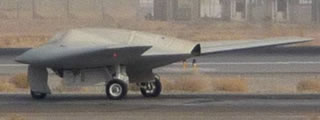
Aviation Week & Space technology Ares blog disclosed Friday that the jet propelled UAV recently spotted at the American airbase in Kandahar, Afghanistan was officially recognized as the RQ-170 Sentinel, built by Lockheed Martin and operated by the U.S. Air Force 30th Reconnaissance Squadron at Tonopah Test Range, Nev., the home of the F-117 squadron, when the project was still classified. It is believed that the Sentinel first flew in 2002-2003. The recent missions at Kandahar were the aircraft was spotted in Afghanistan were not the first in theater. It is believed that the aircraft was operating from remote bases in the Middle East, primarily on night missions, extending its range and mission endurance utilizing aerial refueling.

The type of sensors being used is yet unknown, but likely to be a combination of SAR imaging sensors, probably of a new ‘wing-embedded’ type that could preserve the aircraft stealth characteristics. Such technology is being developed in recent years for the US Air Force SensorCraft program, which has progressing steadily in recent years. Multi-spectral sensor or SIGINT could also be considered for such a platform, primarily for obtaining low-power signals from closer range than possible with larger, non stealthy platforms. Bringing the Sentinel from the Black world to daylight could expand its operational flexibility in theater, paving the way for more extensive operations.
The new aircraft bears some resemblance to the Lockheed Martin Polecat, although it seems to have a single engine and shorter wing span. It has a similar a tailless flying wing design, with sensor and communications pods faired emplaced onto the upper surface of each wing. The Polecat made its first flight in 2005, a year or two after the Q-170. Built by Lockheed Martin with ‘company funding’, the drone, designated P-175 could be an outgrowth of the Sentinel, with longer wing span and two engines, its mission endurance was likely to be around four hours. The single flying Polecat was crashed on a flight test on December 2006. The Polecat was flying while the other two other Joint Unmanned Combat Aircraft System (J-UCAS) being developed for the Navy and Air Force were terminated by the Air Force, just after DARPA delivered the successful and promising program to the Air Force, following an extensive flight testing and weapon delivery demonstrations. The Air Force allegedly was seeking funding for a new stealth bomber, but the service could already have something else in the making.
About two years later the J-UCAS program has been resurrected by the Navy as the X-47D carrier based technology demonstrator, built by Northrop Grumman X-47D. This aircraft could lead the Navy to potentially integrate an unmanned aircraft as part of its carrier Air Groups. By the time the X-47D is flown from a Navy carrier, the U.S. Air Force is also planning to embark on a fast ISR platform known as MQX and a UCAV program of its own. The three aerospace giants, Boeing, Northrop and Lockheed Martin are already preparing for the future UCAV competition. Boeing has launched its Phantom Ray internally funded program, reviving the X-45C technology while Lockheed Martin’s is harnessing several programs, likely to rely on its work on X-47B, Polecat, and Sentinel, to strengthen its stake in the unmanned aircraft world.
















